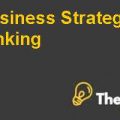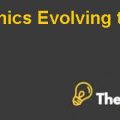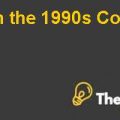
VALUE INVESTING VS GROWTH INVESTING IN NEW ECONOMY
It can be analyzed from the case that the economy of the United States of America was strong as there was low unemployment, less significant inflationary effects and increased productivity. The influence and the impact of the rapid technology changes such as the internet was also being observed on the investment environment very slowly. Due to this reason, the investors were focusing more on the appreciation of the price rather than focusing on the growth of the earnings.
Value investing can prove to be very risky for the investors in time of the new economic conditions. This value can prove to be difficult for the investors because the investors could use different valuation approach to find the intrinsic value of the stocks. This will create doubts due to the increased risks in the minds of the investors regarding the future benefits they are looking for.
It can be analyzed from Exhibit 4 that the cumulative return of BARRA S&P 500 Indices VS the S&P500, the value of the investment which is represented by the Barra Value has been rising since January 1975, more than other investment styles that are indexing investment styles and the growth investment styles as shown by the Barra growth. However, this trend was reversed after 1997 and it was the time when the growth indices were rising much higher than other indices. There were many reasons for this opposite change which include the long term growth prospects of the companies, launch of new technologies, the changing perspectives of the investors due to the changing economy, changes in the preferences of the investors regarding the tradeoff between return and risk, globalization of the company’s operations etc. This signifies the fact that the growth investing styles had outperformed the value investing styles over the years with the pace of the time.
In the same way, Exhibit 1 regarding the capital appreciation of major indices shows that the NASDAQ composite index and the S&P 500 Index have both outperformed in terms of indexing investment styles than the value investing styles in the one year and the two year capital appreciation index. The value investing style here is Russell 1000 value. Altogether Exhibit 1, Exhibit 2 and Exhibit 4 show the trend in different investment styles over the pace of the time and the changing economy and economic conditions. Therefore, it can be said that the superiority of any of the investment styles is dependent not on any one factor but it is dependent on a range of factors such as the change in economy, customer’s confidence levels, inflation levels, rapid and significant changes in the technology, accuracy of the fundamental analysis and the availability of the information.
ANALYSIS OF INVESTMENTS IN CISCO SYSTEMS, CVS, RR DONNELLEY & MANOR CARE
Analyzing the different calculations can reveal us the true facts that why Cisco Systems was not included in the portfolio of GMO rather than CVS AND RR Donnelley.
Price/Book value (Book value multiples):
The PBV ratio has been calculated from the given set of information which has been extracted from the case exhibits in the spreadsheet. This ratio shows that comparison between the current price of the shares in the market and the price of the shares on the balance sheet. This comparison between the market value of the shares and the book value of the shares is used by investors in most of their investment strategies.
If we look at the price to book ratios of all the companies, then Cisco Systems has the highest price of book ratio which is about 26.36 times. This shows that higher price was being paid for the investors than the price that was calculated by an accountant. Therefore, based on the principles of value investment the Cisco System would not be a suitable choice but Manor care, RR Donnelley and CVS Corporation would be. Therefore, on the basis of PBV ratio the recommended choice would be RR Donnelley and CVS Corporation because the investors would think that the price of these stocks would increase in the future. However, further analysis needs to be done to justify this decision.
Price/Earnings ratio:
Most of the investors argue that those stocks that have a PE ratio which is lower than its competitors will outperform in the future. Therefore, the ratio has been also calculated for all of these companies. The PE ratio for Cisco Systems is around 112.87 times in 2002 and it reached to 30 times in 2009 which was more than all other companies..........................................
This is just a sample partial case solution. Please place the order on the website to order your own originally done case solution.











